on TAIPEI Kil'n time in Taipei - Community Services Center
on TAIPEI Kil'n time in Taipei - Community Services Center
on TAIPEI Kil'n time in Taipei - Community Services Center
You also want an ePaper? Increase the reach of your titles
YUMPU automatically turns print PDFs into web optimized ePapers that Google loves.
well, s<strong>in</strong>ce each harks back to millennia of<br />
‘performances’ <strong>in</strong> this ancient art, where<br />
each lift and pressure of the wrist is read<br />
as movement <strong>in</strong> sequence, as dance <strong>in</strong><br />
<strong>time</strong>. This aside from the philosophical or<br />
poetic c<strong>on</strong>tent of the <strong>in</strong>scribed literary texts<br />
themselves now re-presented as visual art.<br />
C<strong>on</strong>tent versus Soul<br />
Renewal and ‘Ch<strong>in</strong>eseness’ can be created<br />
not <strong>on</strong>ly with traditi<strong>on</strong>al media, as these<br />
are so<strong>on</strong>er brought to greater advantage,<br />
but with entirely foreign materials as well.<br />
This is dem<strong>on</strong>strated by the Taiwan artist<br />
resident <strong>in</strong> France, Chu Teh-ch’ün 朱 德<br />
群 , whose hoary Western canvasses are<br />
enlivened with thick, unctuous Western<br />
oil colors <strong>in</strong> compell<strong>in</strong>g comb<strong>in</strong>ati<strong>on</strong>s that<br />
even ‘through the French t<strong>on</strong>gue’ impart<br />
a feel of Ch<strong>in</strong>ese landscapes and ancient,<br />
eternally Ch<strong>in</strong>ese sensibilities. Chu manages<br />
to create the spatial ambivalence that<br />
<strong>in</strong>vites the viewer to roam and to dwell<br />
there<strong>in</strong>. This is not unlike creat<strong>in</strong>g out of<br />
Western <strong>in</strong>gredients like tomato, potato<br />
or corn tasty dishes that taste entirely<br />
Ch<strong>in</strong>ese. While translucency of <strong>in</strong>k and<br />
colors provide ambivalence that give<br />
the sense of movement and change and<br />
emoti<strong>on</strong>ality to any pa<strong>in</strong>t<strong>in</strong>g, with adroit<br />
handl<strong>in</strong>g even dark, rich, opaque oils as <strong>in</strong><br />
Chu Teh-ch’ün’s large canvases, can by their<br />
formal relati<strong>on</strong>ships speak of change and<br />
movement. It is a step removed from the<br />
immediacy of translucent Ch<strong>in</strong>ese pigments,<br />
but it can be given a ‘Ch<strong>in</strong>ese’ life by a true<br />
master. Am<strong>on</strong>g the most poignant examples<br />
of a haunt<strong>in</strong>gly Ch<strong>in</strong>ese expressi<strong>on</strong>, yet<br />
entirely Western <strong>in</strong> medium and c<strong>on</strong>tent, are<br />
the elegiac pa<strong>in</strong>t<strong>in</strong>gs of the master Ch’ang<br />
Yü 常 玉 (1901-1966) who lived and died <strong>in</strong><br />
Paris. Ch’ang’s works derive from Matisse<br />
and are yet entirely Ch<strong>in</strong>ese <strong>in</strong> their poetic<br />
lyricism, where each work is imbued with<br />
the fragrance of pathos and isolati<strong>on</strong>, of<br />
yearn<strong>in</strong>g that is unstoppable, of love that is<br />
unrequited, verg<strong>in</strong>g <strong>on</strong> the broken-hearted<br />
laments of cloistered Ch<strong>in</strong>ese women of the<br />
19th and early 20th centuries. Interest<strong>in</strong>gly,<br />
with Ch’ang Yü, it is not c<strong>on</strong>stant moti<strong>on</strong><br />
or ambiguity that create the Ch<strong>in</strong>ese feel<strong>in</strong>g<br />
of yi ( 易 ) or change. Ch’ang’s colors are<br />
very often opaque and still; his forms,<br />
animals, figures, flowers or still life, are<br />
pa<strong>in</strong>ted <strong>in</strong> solid colors, some<strong>time</strong>s bounded<br />
<strong>in</strong> stark black l<strong>in</strong>es. They always manifest<br />
quiescence and vacuumed stillness. The<br />
heart-rend<strong>in</strong>g moti<strong>on</strong> and emoti<strong>on</strong> of<br />
Ch’ang’s pa<strong>in</strong>t<strong>in</strong>gs, that <strong>in</strong>deed swirl like<br />
a whirlw<strong>in</strong>d <strong>in</strong> our heads, derive from the<br />
forms themselves; their <strong>in</strong>terrelati<strong>on</strong> to<br />
each other. Especially compell<strong>in</strong>g is their<br />
relati<strong>on</strong>ship to the yawn<strong>in</strong>g space around<br />
them, <strong>in</strong>f<strong>in</strong>ite spaces that would swallow<br />
them up <strong>in</strong>to eternal darkness. It is <strong>in</strong> this<br />
c<strong>on</strong>trast that these forms seem to move, to<br />
emote, to sigh and to weep.<br />
Qu<strong>in</strong>tessentially Ch<strong>in</strong>ese, yet also<br />
modern<br />
And here like the well-known Liu<br />
Guos<strong>on</strong>g, Chu Teh-ch’ün, Ch’ang Yü, and<br />
Wang Jiqian are <strong>in</strong> their respective lights<br />
outstand<strong>in</strong>g Ch<strong>in</strong>ese masters of Twentiethand<br />
Twenty-First Century art. And this<br />
is how Ch<strong>in</strong>ese artists liv<strong>in</strong>g and work<strong>in</strong>g<br />
abroad can ma<strong>in</strong>ta<strong>in</strong> and update their native<br />
traditi<strong>on</strong> and excel. Wang, Ch’ang and<br />
Chu fully provide the answer for Ch<strong>in</strong>ese<br />
emigrant artists, whether us<strong>in</strong>g traditi<strong>on</strong>al<br />
or Western media, for when us<strong>in</strong>g foreign<br />
media, all four are able to transform their<br />
applicati<strong>on</strong> <strong>in</strong> such a way as to produce<br />
the qu<strong>in</strong>tessential Ch<strong>in</strong>ese feel that is at<br />
the same <strong>time</strong> thoroughly ‘modern’ and<br />
communicable <strong>on</strong> an <strong>in</strong>ternati<strong>on</strong>al basis.<br />
There is no need to imitate expressi<strong>on</strong>s<br />
that are not <strong>on</strong>e’s own. It has never been<br />
the medium of <strong>in</strong>k brush and paper that<br />
has become outdated, as so many ‘modern<br />
revoluti<strong>on</strong>aries’ still claim. It is the creative<br />
m<strong>in</strong>d of Ch<strong>in</strong>ese people that <strong>in</strong> the past<br />
120 years or so have shrunken <strong>in</strong> pathetic<br />
self-doubt; so much so as to become<br />
bl<strong>in</strong>d to the <strong>in</strong>f<strong>in</strong>ite potential of Ch<strong>in</strong>ese<br />
traditi<strong>on</strong> <strong>in</strong> its ever-possible renewal. Let<br />
us look at the f<strong>in</strong>ely outl<strong>in</strong>ed and evocative<br />
works of Beij<strong>in</strong>g-born architect pa<strong>in</strong>ter<br />
Chen Qikuan (Chikwan 陳 其 寬 , 1921-<br />
2007) whose advent resembles the div<strong>in</strong>e<br />
m<strong>on</strong>key Sun Wuk<strong>on</strong>g <strong>in</strong> the epic M<strong>on</strong>key<br />
about Xuanzang's journey to the West<br />
for the can<strong>on</strong>ic Buddhist Tripitaka. The<br />
mischievous and magical m<strong>on</strong>key <strong>in</strong><br />
Xuanzang’s ret<strong>in</strong>ue took worldly form not<br />
by a mother birth but by jump<strong>in</strong>g out of a<br />
rock. Similarly, Chen has no predecessors,<br />
nor followers. His is a world apart, yet<br />
entirely Ch<strong>in</strong>ese and entirely c<strong>on</strong>temporary.<br />
Due to lack of visi<strong>on</strong> <strong>on</strong> the part of clients,<br />
creative <strong>in</strong>novati<strong>on</strong>s <strong>in</strong> Chen’s build<strong>in</strong>gs<br />
were mostly restricted except for Taichung’s<br />
D<strong>on</strong>ghai University campus. Here his<br />
breathtak<strong>in</strong>g Luce Chapel predates many<br />
other build<strong>in</strong>gs us<strong>in</strong>g torque <strong>in</strong> re<strong>in</strong>forced<br />
c<strong>on</strong>crete: it rises <strong>in</strong> four large, gently curved<br />
slabs jo<strong>in</strong>ed <strong>on</strong> top as hands <strong>in</strong> prayer. In<br />
his pa<strong>in</strong>t<strong>in</strong>gs Chen displayed the multiperspective<br />
renditi<strong>on</strong> of view<strong>in</strong>g a scene<br />
from fr<strong>on</strong>t and at the same <strong>time</strong> from<br />
Chen Qikuan - Interpenetrati<strong>on</strong><br />
june 2010<br />
19



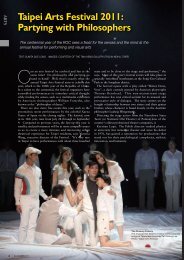
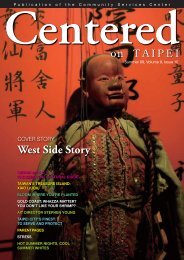



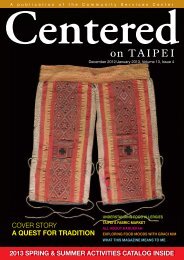

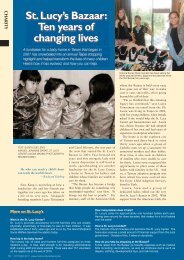

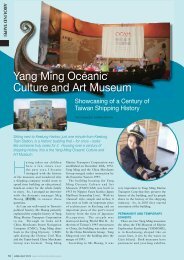



![Rice 米 [mi] - Community Services Center](https://img.yumpu.com/22967832/1/184x260/rice-mi-community-services-center.jpg?quality=85)